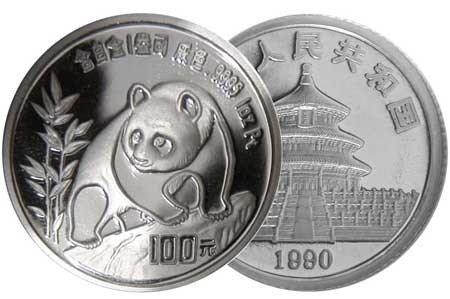Chinese Coins: Platinum Pandas
Posted on 9/11/2013
By
Peter Anthony
Of the almost six hundred Panda coins and medals issued by the China Mint, just a handful are made of metals other than gold or silver. There are a few copper, some brass, a bronze or two, and a quartet of palladium Pandas. The most prominent metal among the outliers is platinum. Between 1987 and 2004 there were 20 different platinum Panda coins and medals struck. Practically all of them have both low mintages and low survival rates and they’re well worth exploring.
The most prominent platinum Pandas are also the oldest. From 1987 through 1990 the China Mint gave the world four 1 oz. coins and a single 1 oz. medal. This was a good time period to be selling platinum products as metal prices more than doubled between 1986 and 1988. This created a strong market. By 1990 the boom was over and the price of platinum fell sharply. So did demand and just 800 of the 1990 platinum Pandas were minted.

The 1990 has the lowest mintage of all 1 oz. platinum Pandas: just 800.
Added all together a little less than 9,000 1 oz. platinum Pandas were struck. A safe estimate is that less than half that number still exist today. Why? In the mid-90s platinum had several run-ups in price. During these spikes the melt value of the coins was higher than what dealers could sell them for – if they could find buyers. Many dealers decided to melt down their platinum Panda inventories to make bars that could be easily sold at then-current prices. We can thank collectors for the surviving examples as nearly every dealer of that period has a story about melting down platinum Pandas.
In 1990, the China Mint also tried to sell platinum Pandas in smaller ½ oz., ¼ oz. and 1/10 oz. weights. In a cold market these flopped too and no additional ½ oz. or ¼ oz. platinum Pandas were ever issued.
By 1993 the China Mint came back with a new strategy: 1/10 oz. and 1/20 oz. platinum Pandas for sale to the jewelry trade. That’s why so many coins bear the scars of having been mounted in rings and bracelets. If graded, these coins often fall to Proof 63 or lower. Many were also melted so essentially all the 1990 coins are scarce in higher grades. Some like the 1997s are truly rare and bring very high prices.
In 2002 the China Mint gave platinum Pandas one last whirl. For the 20th anniversary of the series they struck a 1/10 oz. Panda with a special design. It is the only coin in Panda history to have bears on both obverse and reverse sides. The announced mintage of 20,000 is much higher than previous coins yet these too are rarely seen.
Platinum Pandas made their last appearances in 2003 and 2004 as little 1/20 oz. coins with denominations of 50 Yuan. Mintages climbed to 50,000. While the 2003 isn’t too hard to locate, the 2004 is more of a challenge.
Putting together a complete set of the 20 platinum Pandas would be a major challenge. Each of these coins, though, can be appreciated for its own beauty and scarcity. An old friend of mine used to tell me, “Every dog has its day.” I expect that every Panda will, too. When that day comes, the platinum Pandas will finally get the attention they deserve.
Peter Anthony is an expert on Chinese modern coins with a particular focus on Panda coins. He is an analyst for the NGC Chinese Modern Coin Price Guide as well as a consultant on Chinese modern coins.
Stay Informed
Want news like this delivered to your inbox once a month? Subscribe to the free NGC eNewsletter today!
